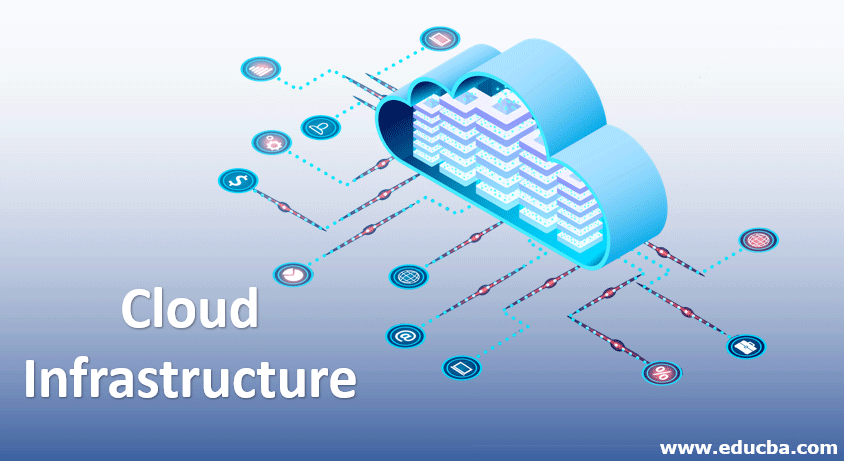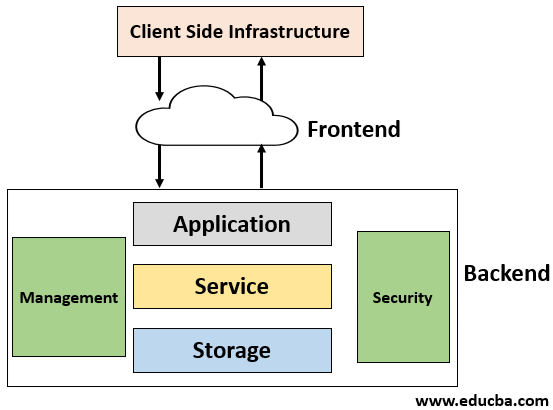
Introduction to Cloud Infrastructure
The term infrastructure refers to the physical structure on which platforms are present, and facilities are available. Thus, the term cloud infrastructure refers to the physical architecture, computing systems that perform and shows activity on the cloud server. It is the aggregation of various hardware and software components that perform specific actions depending upon the cloud-computing model’s requirements. The infrastructure also consists of a layer and various networking applications connected remotely through a wide variety of networks, maintained by a large size database because of the huge collection of resources.
Cloud Infrastructure Diagram
This is the basic diagram that helps in understanding the basic components flowing through the cloud:
Below are a few points that will help in understanding the overall architecture in a detailed way:
Cloud infrastructure consists of mainly two parts:
- Front-end side: Which is the client-side and where the server is located.
- Back-end side: This consists of all applications and storage management.
Below consists of a few points regarding the cloud infrastructure diagram:
- The front-end side of the infrastructure, also known as the client-side, consists mainly of the server and all network connections. The connection takes place through middleware platforms and virtual connections that pass the necessary information to the server.
- The back-end platform consists mainly of the major hardware components and application stacks like switches and routers, storage devices, electronic devices that directly connect through the internet platform, and connection takes place via secured medium for effective communication.
- The middleware platform performs a special role in gathering data from the applications in the back-end and provides an effective response through the same channel to pass the same to the cloud server maintaining data security and integrity and preventing data loss.
- The infrastructure mainly consists of storage in the form of disks in the form of a distributed file system that helps handle huge chunks of data.
Top 9 Advantages of Cloud Infrastructure
Cloud Infrastructure provides a variety of advantages that makes things easy for us since it contains only a strong cloud server that consists of all the data storage without having the headache to store data in different servers and file systems.
1. Cost-Effective
First is the cost of application services and hardware platforms that are very less as compared to other computing services that run on the subscription plans. The payment services of the cloud computing systems work on a pay-per-use basis where users can use their choice services and make payments according to them.
2. Enhanced Performance and Quality
The cloud servers’ services are reliably producing maximum output with minimum workload maintaining 99% efficiency with improved quality. The application also provides the user with the benefit of access from anywhere.
3. Storage Capacity and its Flexibility
The increased storage server of cloud infrastructure provides a huge capacity for storing large chunks of data and offers flexibility in the storage capacity by responding quickly to increasing data storage depending upon user requirements and reducing the size when it’s done, maintaining cost optimization. Additionally, incorporating Artificial Intelligence and Machine Learning Services can further enhance the efficiency and effectiveness of managing and analyzing this data, ensuring smarter and more responsive cloud infrastructure solutions.
4. Improved Software Updates
In the cloud, the server programs remain in sync and provide up-to-date actions. The security updates are much faster since updates happen automatically and are periodically refreshed without requiring a manual step. In such a case, it saves a lot of time in manual labor and saves costs.
5. High Data Security
There have been questions regarding security since a huge amount of data is regularly synchronized through a single server. However, cloud computing has made things easy and more secure as it provides a very advanced security feature maintaining data protection and security of its applications. It provides systematic authentication and encrypted data that ensures secure communication and improved data over networks, removing a data breach’s headache.
6. Smooth and Better Collaboration
Cloud computing helps users from every part of the globe to share information and ideas through a secured shared system. It helps in smoothening customer services and collaborating with employees across different organizations.
7. Improved Data Control
There are a lot of mishaps occurring where the correct data is not transferred to the right person. Now, cloud computing provides a much-enhanced control system that helps the user choose a person and access the data for the end-user. This helps in improving the level of control for each data so that it reaches the correct end medium, which needs access to that data.
8. Maintenance and Management
Cloud computing provides more efficient and advanced management services and provides enhanced maintenance, which helps the user enjoy a modified user interface without installing resources.
9. Proper Functioning and its Sustainability
Cloud computing only requires an internet connection to connect globally to any applications virtually through any network. So communication through the cloud makes it more sustainable and environment-friendly as it removes physical products’ needs.
Working of Cloud Infrastructure
Cloud computing works on the process of effective data management and communication through servers. Since today’s world, everything has been connected through networks that make life easy for the end-users to communicate and use the data through shared servers. Cloud servers mainly work on three models.
They are:
- Software as a Service (SaaS): The customer receives the platform’s software services and has the flexibility to pay as per usage basis.
- Platform as a Service (PaaS): This model provides the basic environment where software is tested, maintained and finally reaches the end-users.
- Infrastructure as a Service (IaaS): This model produces an entire infrastructure where resources, networks, and mechanisms remain interconnected in building a huge organization.
Conclusion
Cloud Infrastructure provides more constructive and advanced use of resources that helps businesses grow for the long term in improved production, collaboration, and security, utilizing shared resources and maintaining an effective communication method.
Recommended Articles
This is a guide to Cloud Infrastructure. Here we discuss the introduction to cloud infrastructure and its working along with advantages. You can also go through our other suggested articles to learn more –


